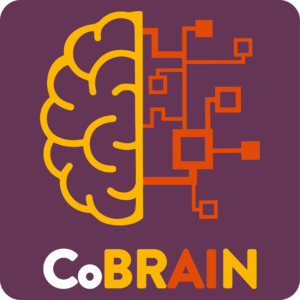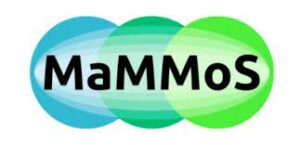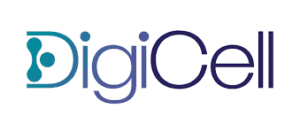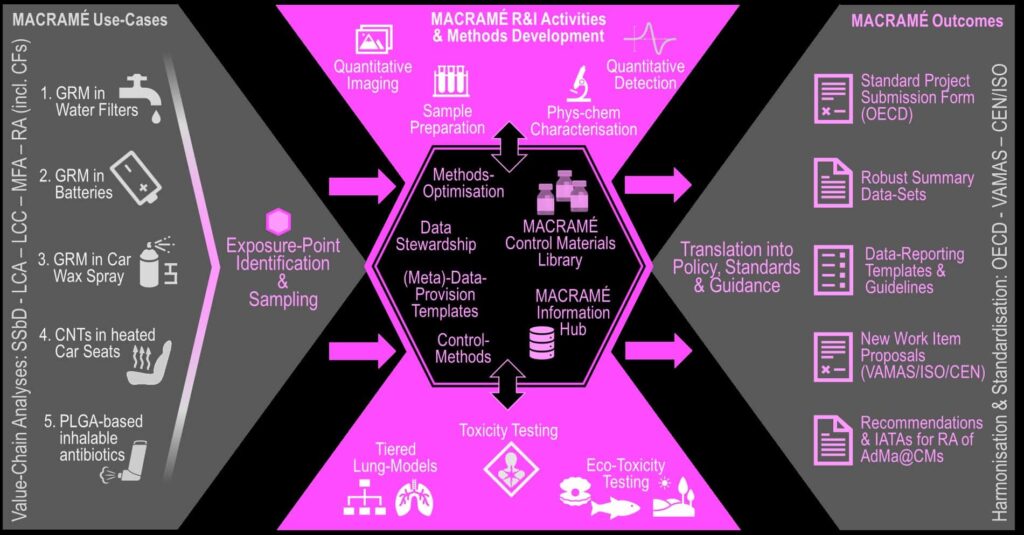PINK’s objectives: Safe-and-Sustainable-by-Design (SSbD) advanced materials and chemicals (AdMas&Chems) are a central requirement for reaching the ambitious goal of making Europe the first digitally-enabled circular, climate-neutral and sustainable economy. Such new AdMas&Chems need to provide the high functionality required for their advanced applications, whilst simultaneously exhibiting improved safety and sustainability performances that take into account the complete value chain and life cycle, as outlined in the SSbD framework proposed by the EU Joint Research Centre and adopted in the Commission Recommendation of 8 Dec. 2022. To facilitate adoption by industry and, by doing so, foster the twin green and digital transition of Europe’s economy, PINK’s overarching aim is to produce innovative modelling software and integrated workflows for the development of AdMas&Chems, which are combined into an industry-ready open innovation platform, the PINK In Silico Hub (PINKISH).
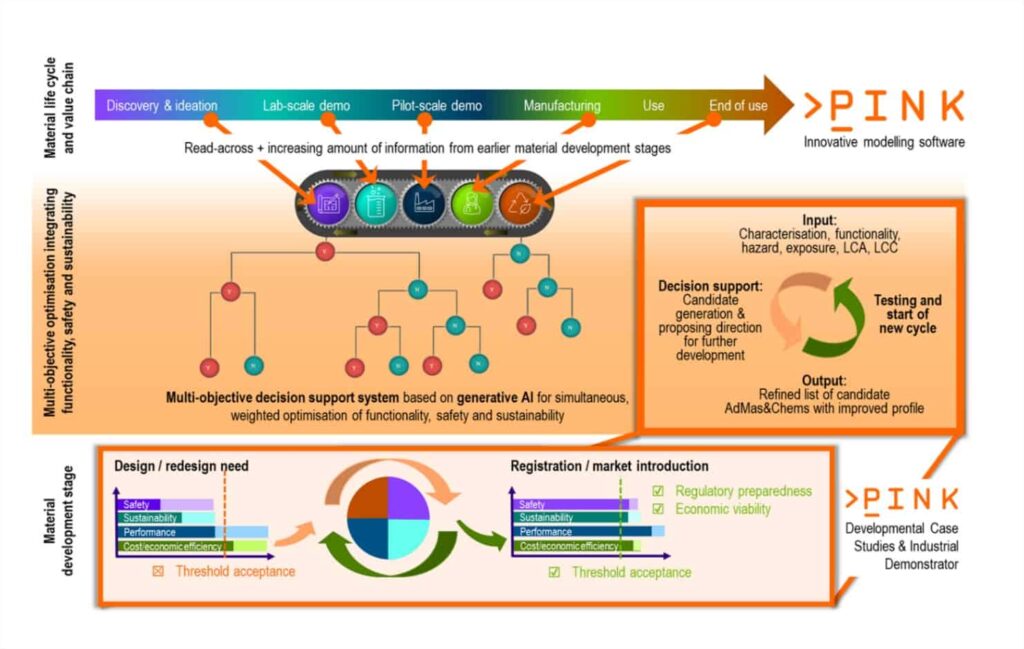 PINK’s approach: PINK takes a holistic approach addressing the needs of industry by solving a multi-objective optimisation problem to improve and balance the four requirement categories functionality, cost-efficiency, safety and sustainability. All five steps of the SSbD Framework (hazard assessment, human health and safety aspects in the production and processing phase, human health and environmental aspects in the final application phase, environmental sustainability assessment, and socio-economic sustainability assessment) are integrated into selection considerations at each stage of the AdMas&Chems development, starting with a limited set of evaluation criteria and rough estimates (low-tier methods) and moving to higher-tier methods in later stages. In this way, confidence in the predictions is continuously improved over multiple design cycles by producing new knowledge on a constantly reduced set of better performing candidates.
PINK’s approach: PINK takes a holistic approach addressing the needs of industry by solving a multi-objective optimisation problem to improve and balance the four requirement categories functionality, cost-efficiency, safety and sustainability. All five steps of the SSbD Framework (hazard assessment, human health and safety aspects in the production and processing phase, human health and environmental aspects in the final application phase, environmental sustainability assessment, and socio-economic sustainability assessment) are integrated into selection considerations at each stage of the AdMas&Chems development, starting with a limited set of evaluation criteria and rough estimates (low-tier methods) and moving to higher-tier methods in later stages. In this way, confidence in the predictions is continuously improved over multiple design cycles by producing new knowledge on a constantly reduced set of better performing candidates.
The PINK team: To provide all the expertise needed to achieve ambitious goals, PINK assembled a consortium of 16 partners from Slovenia, Germany, Belgium, Norway, Italy, Greece, Cyprus, Luxembourg, Finland, Sweden, Austria, UK, and Switzerland funded under the EU Horizon Europe call HORIZON-CL4-2023-RESILIENCE-01-23 - Computational models for the development of safe and sustainable by design chemicals and materials (RIA).
Duration
Start: 01.01.2024
End: 31.12.2027




 Due to crises such as the coronavirus pandemic or suspended trade agreements, supply bottlenecks occur repeatedly. Raw materials like nickel, magnesium and rare earths, which industries need to manufacture a wide range of products, are often unavailable for extended periods. This is where a new flagship project by the Fraunhofer-Gesellschaft comes into play: »ORCHESTER« addresses the challenges of the circular economy and security of supply, in particular with functionally reliable materials for the energy transition along the entire value chain.
Due to crises such as the coronavirus pandemic or suspended trade agreements, supply bottlenecks occur repeatedly. Raw materials like nickel, magnesium and rare earths, which industries need to manufacture a wide range of products, are often unavailable for extended periods. This is where a new flagship project by the Fraunhofer-Gesellschaft comes into play: »ORCHESTER« addresses the challenges of the circular economy and security of supply, in particular with functionally reliable materials for the energy transition along the entire value chain.

 PINK’s approach: PINK takes a holistic approach addressing the needs of industry by solving a multi-objective optimisation problem to improve and balance the four requirement categories functionality, cost-efficiency, safety and sustainability. All five steps of the SSbD Framework (hazard assessment, human health and safety aspects in the production and processing phase, human health and environmental aspects in the final application phase, environmental sustainability assessment, and socio-economic sustainability assessment) are integrated into selection considerations at each stage of the AdMas&Chems development, starting with a limited set of evaluation criteria and rough estimates (low-tier methods) and moving to higher-tier methods in later stages. In this way, confidence in the predictions is continuously improved over multiple design cycles by producing new knowledge on a constantly reduced set of better performing candidates.
PINK’s approach: PINK takes a holistic approach addressing the needs of industry by solving a multi-objective optimisation problem to improve and balance the four requirement categories functionality, cost-efficiency, safety and sustainability. All five steps of the SSbD Framework (hazard assessment, human health and safety aspects in the production and processing phase, human health and environmental aspects in the final application phase, environmental sustainability assessment, and socio-economic sustainability assessment) are integrated into selection considerations at each stage of the AdMas&Chems development, starting with a limited set of evaluation criteria and rough estimates (low-tier methods) and moving to higher-tier methods in later stages. In this way, confidence in the predictions is continuously improved over multiple design cycles by producing new knowledge on a constantly reduced set of better performing candidates.




